Mixergy Heat Pump Performance
Social media seems to be awash with negative stories about renewables.
Heat pumps in particular get the most attention, which has now filtered down to other associated technologies too, like water cylinders.
Mixergy, with their ‘smart’ water cylinder have not been immune to these stories. Reports that they aren’t all they are cracked up to be.
I must hold my hand up here and say that I’ve not helped their cause with my constant questioning on social media of the performance of my Mixergy cylinder since upgrading to a heat pump.
I may well have planted seeds of doubt in the minds of my Twitter followers that have indeed stuck with them.
I’m hoping this article will go some way to address previous complaints and set the record straight.
Background
I have owned my 250L Mixergy ‘direct’ cylinder since February 2022.
It was installed as part of my long term transition to get off gas. Initially allowing me to stop using our gas combi boiler for hot water and use the Mixergy via electric (whilst keeping the gas boiler for heating).
During that first summer the electricity came from a combination of overnight cheaper rates on Octopus Go tariff as well as surplus solar PV diverted using a myenergi Eddi diverter.
I spoke at length about the whole Mixergy installation project in the following blog post.
In October of that year we had the heat pump installed, a 5kW Vaillant Arotherm Plus. Again, this has been detailed in a separate post.
To upgrade the Mixergy cylinder to be heat pump ready we had to purchase and install (bolt-on) the Mixergy heat pump kit, which comprises a plate heat exchanger (see photo), an external pump and an electronic interface module.
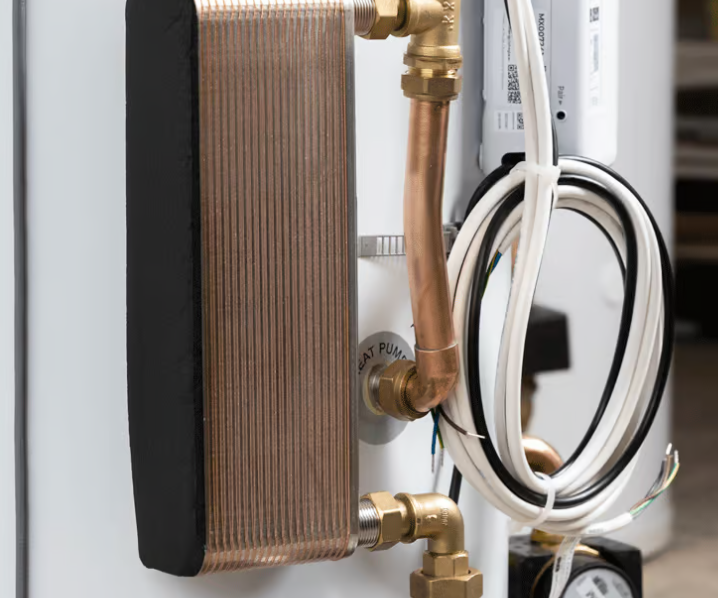
Whilst I was happy enough with the home heating performance of the heat pump during that first winter, I was a little disappointed when generating hot water.
I go into depth in my ‘first winter with my air source heat pump’ article:
I always assumed that the poor hot water performance was because my Mixergy cylinder (and its plate exchange) just wasn’t up to the job. Jack of all trades, master of none so to speak.
I was wrong.
In this article we will go through the differences between a Mixergy attached to a heat pump compared to a standard cylinder and look at a lot of monitoring data, analyse the results and then look how to get the best out of the Mixergy and any cylinder with a heat pump.
TL:DR (too long; didn’t read)
The Mixergy performs just as well, if not better than most conventional cylinders when connected to a heat pump. Achieving 480% efficiency at 12C outside when heating to 45C cylinder target temperature. And over 400% efficiency when heating to 48C target when less than 10C outside.
If you were dead set on a Mixergy, but heard some of performance woes online, fear not. The Mixergy more than capable of holding its own with the best coil based cylinder out there.
Stats and data within the article, please read on.
Benefits of a Mixergy Cylinder
The benefit of the Mixergy is that it can come with you on a journey. When you initially purchase it, you could be on gas. Then you might start to use direct electricity, perhaps with cheaper overnight tariffs and then finally move to a heat pump.
The Mixergy can do all these jobs. Heating via gas uses a coil at the top of the indirect version of the cylinder, direct electric uses a 3kW immersion (which can also be used for Solar PV diversion) and with a heat pump you attach their plate heat exchange, pump and interface kit.
A conventional cylinder with a coil on a gas system would not be suitable for use on a heat pump as the coil is normally too small. A heat pump needs a large coil within the cylinder to transfer the heat.
And when using gas or direct electric you can also part load the Mixergy cylinder. Only heating what you need, say 50%. And there is an element of AI that can learn your habits and only heat the cylinder to what you normally require.
Sadly, part loading doesn’t really work with heat pumps. You can choose it in the app. But you really need to heat to 100% with a heat pump.
So why was my Mixergy performance not so good?
It turns out the performance issues I saw when heating from the heat pump were entirely my fault. I was trying to throw full output from the heat pump into the cylinder using ‘Normal’ hot water mode on the Vaillant.
Any cylinder (coil or plate) will not like this.
So the way to get the best hot water performance from a heat pump is to use a reduced compressor mode.
This is the same advice when heating the home with a heat pump. Slow and steady wins the race.
On the Vaillant Arotherm you can reduce the compressor by using the ‘Eco’ hot water mode.
I wrote an article that explains the three modes; Eco, Balance and Normal.
There may be a different way of doing this on other brands of heat pump. Maybe ‘quiet’ modes or ‘reduced duty’. But definitely something to explore.
You just need to find the setting on the heat pump that moves the energy to the cylinder with less strain on the heat pump and compressor.
Once I started using Eco mode it was like a revelation. Performance (COP) took an instant leap upwards.
You can see on this chart where I compare my 2022/2023 winter data to 2023/2024 winter data.
I used Normal mode in 2022/2023 (red on the graph) and I used Eco mode in 2023/2024 (yellow on the graph).

Wow, it jumps out at you doesn’t it.
The level of performance from Eco mode blows away what you can get on Normal.
In sub zero temperatures there looks to be a COP difference of around 0.4 to 0.5 and as it warms up outside that trendline extends out towards COP 1.0 difference and beyond.
My Mixergy performance versus other cylinders
One of the reasons I was disappointed with my performance last winter is because I was constantly comparing my hot water runs to other folks on http://heatpumpmonitor.org
Heat Pump Monitor by Open Energy Monitor is an open source project where people can add the performance information from their heat pump and share all their details. At the time of writing there are over 70 heat pumps listed.
It can be a blessing and also a curse, LOL.
But ultimately it is a fantastic way to get more performance out of your heat pump installation by comparing and asking questions about what others are doing with their installations.
The thing I finally realised is that I was comparing my ‘full blast’ Normal runs against people running Eco mode. So regardless of what small changes and tweaks I made I was never going to win that race.
There are a number of people on http://heatpumpmonitor.org/ that I’ve cast envious eyes over in the past year because of their hot water run performance.
The main protagonists are:
- Adam (Heat Geek), 7kW Arotherm, 300L Newark Cylinder, 6msq dual coil
- Data available: https://emoncms.org/app/view?name=Primary&readkey=eec7334e58f2a6927a9ff7b27c8c7e63
- Glyn (his parents install), 5kW Arotherm, 200L Telford Cylinder, 3.2msq coil
- Data available: https://emoncms.org/app/view?name=MyHeatpump&readkey=871ad5efb8f20f698f12d751aea9b8a6
- Trystan (open energy monitor), 5kW Ecodan, 150L Newark Cylinder, 3msq dual coil
- Data available: https://emoncms.org/midterrace
And then me
- Mick, 5kW Arotherm, 250L Mixergy Cylinder, 3msq (equivalent) plate heat exchanger (PHE)
- Data available: https://emoncms.org/energystatsuk
The other 3 systems were chosen as they all have similar run characteristics as myself. ie, preferring just one or two long runs a day and the Vaillant systems are already using Eco mode.
Over the course of November 2023 to January 2024, after discovering Eco mode myself, I started to collect DHW runs data from all four of the installations above.
All of which were manually scraped from https://heatpumpmonitor.org/ and transposed into an Excel spreadsheet for offline analysis.
How to normalise the data
Everyone chooses to heat their hot water to different temperatures.
Hotter water gives you more usable water, but it takes more energy to do this and as such, reduces system performance.
The hotter the flow temperature the heat pump has to reach, the lower the performance.
This is the same regardless of whether you are doing space heating or hot water runs.
Here’s the target hot water temperatures of the 4 monitored systems
- Adam: 45C
- Glyn: 48C
- Trystan: 45C
- Mick: a mix of 48C and 51C
So the lowest common denominator is 45C.
For example, when hot water runs complete on Adam’s cylinder, the return temperature across the whole dataset was somewhere between 45C and 46C.
The temperature probe in a conventational cylinder is what tells the heat pump to stop heating. ie, i’ve reached the required temperature.
This probe is usually around two-thirds down the cylinder. So the water above the temperature probe may be slightly hotter and some will likely be slightly cooler.
In a Mixergy the signal to stop is dictated by the temperature probe right at the bottom of the cylinder. Known as the ‘Bottom Temperature’ when you look at their app.
So in this case, you can assume that almost all the water in the cylinder is at target temperature.
Here is a snapshot of a hot water run from Adams cylinder.

The beauty of heatpumpmonitor.org is that I can simulate all the 4 heat pumps running up to 46C return. And as such, infer that all cylinders will be around 45C store temperature at this stage.
Yes, I agree this methodology isn’t totally exact and that each setup (and each hot water run) may have various uncertainties, especially due to temperature probe placement.
But I do think this gets all the hot water runs in the same ball park. Similar enough for a good comparison.
As you can see from this diagram, this shows a complete ‘Eco’ hot water run from my heat pump and Mixergy to around 52C flow / 50C Return.
With a COP of 3.67 when 4.4C outside.

if I highlight everything to the left of the yellow section, ie the parts of the heating run below 46C return, the Open Energy Monitor Heat Pump app will zoom in to this section.
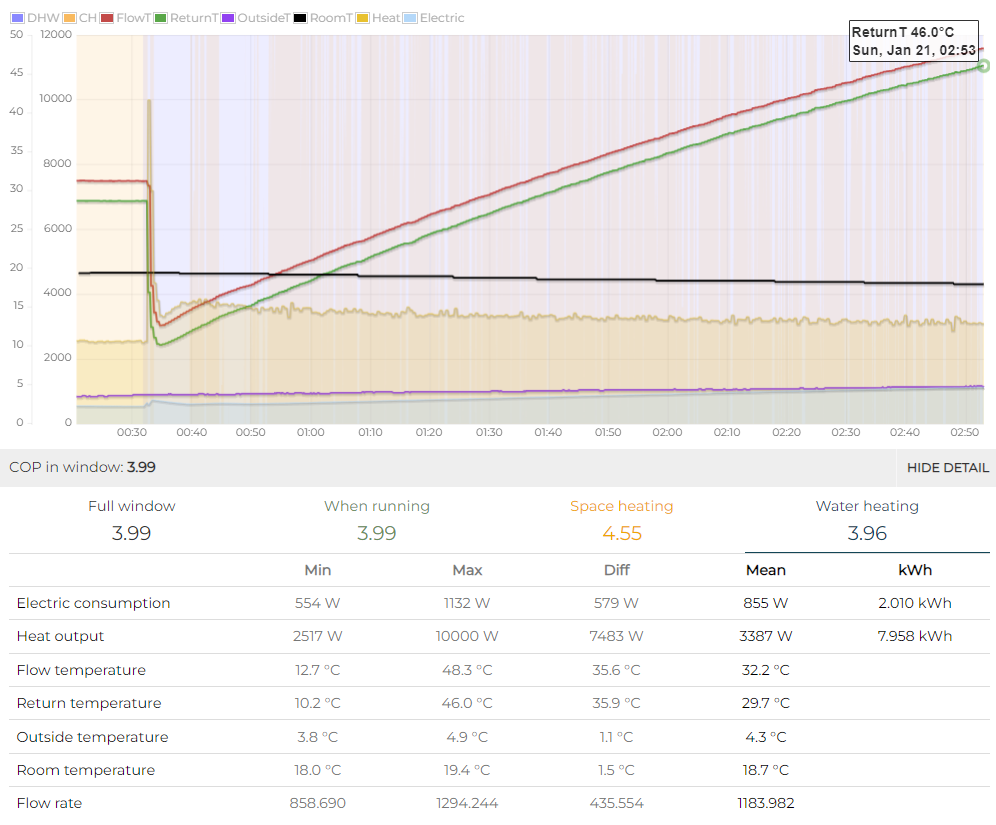
The result of that zooming in is a run that finishes at 46C return.
The COP on this cutdown run is 3.96
This is the methodology I’ve used with all the hot water runs hotter than 46C.
I went through 3 months of runs doing this technique and collecting the data in a spreadsheet.
So by cutting every hot water run from Mick and Glyn short to 46C return we have like for like data to compare against the lowest common denominators (Adam Heat Geek’s and Trystan hot water runs).
Yes, there are going to be slight 0.5C or 1.0C differences along the way in 3 months of data from 4 different systems, I understand that.
For each hot water run we also collect the outside temperature of the runs so that we can compare that too. But again, some folks use hardware temperature probes to feed Open Energy Monitor and some rely on local weather stations using internet weather. So certainly some scope for variance there.
The other thing we don’t quite know is how empty the cylinder was to start with on each run. And because the cylinders are various capacities there is a little variability there too; 300L, 200L, 150L, 250L.
But I do know from studying all 4 systems over a few months that we all prefer to do just one or two runs a day, favouring emptier starting points and longer run times.
This cut-off / comparison technique works because every hot water run on a heat pump just starts at the temperature of the cold water and increases the temperature until the target is reached. You can see this in all the performance graphs.
This cutting short technique is the same as if we’d chosen a around a 45C cylinder target temperature in the first place.
Here is the result of all those data points collected across 3 months of hot water runs. All runs capped at around 46C return temperature for those runs that were taken hotter.
The solid trend line shows an average COP of the hot water runs at different outside temperatures across the whole data set.

You can see that Glyn (blue) and Trystan (green) trendlines drop off once the outside temperature rises above around 4C. Unexplained, but curious nonetheless.
The big headline from the study though is that my Mixergy cylinder (red) matches the dual coil (6m square) cylinder that Adam (yellow) had custom built solely to get the very best hot water performance.
Talk about instantly quashing all the social media (and my) claims that Mixergy cylinders don’t perform?
You can see Adam talking about his custom built cylinder in this video from his YouTube channel.
As this analysis took place in winter, the outside temperatures were low, which in turn lead to lower COP.
But I still got COP of nearly 3 when sub zero temperatures and COP 2.5 on hot water when -5C outside.
You can see in the graph that as the outside temp increases so does the performance.
At the very top right f the graph you can see there is a single run from Adam’s setup at 15C outside with a COP of over 5, so 500% efficient on hot water. Which shows how amazing Adam’s Newark cylinder is.
The warmest day for my setup during the study was 12C outside where my Mixergy achieved 480% efficiency when cropped to 46C return.
See the trace below for my Mixergy run from Open Energy Monitor. So very similar performance.
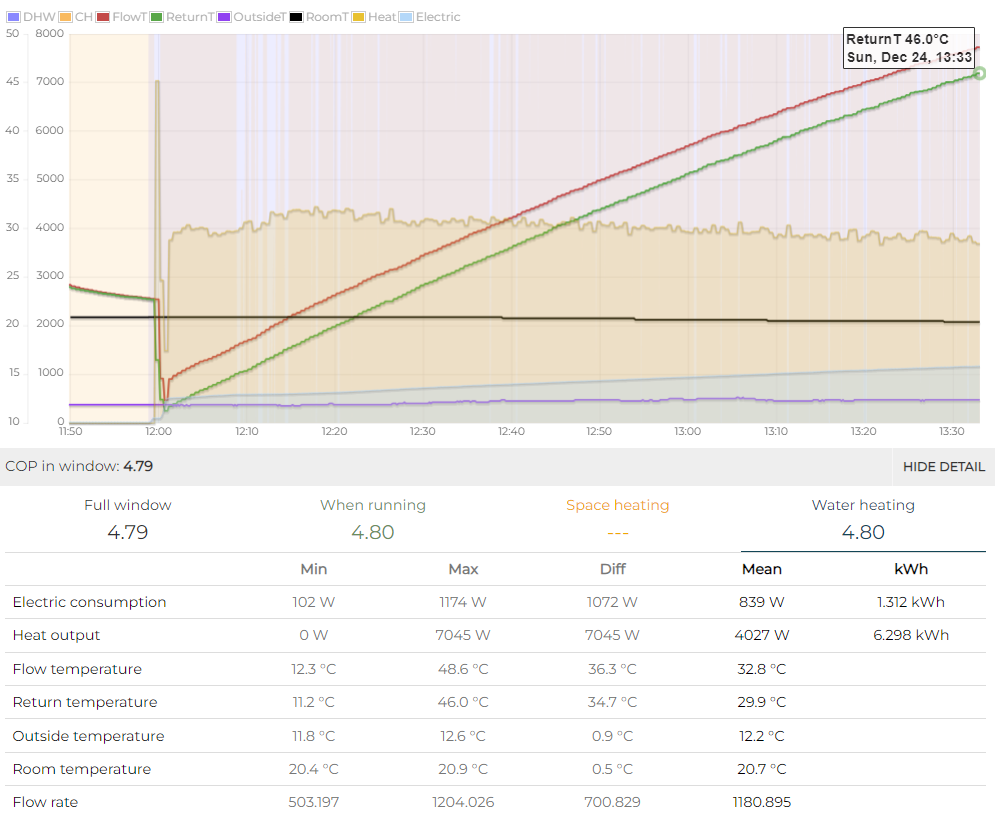
I see no reason why the Mixergy cannot continue to match Adam’s performance as we move into spring and summer and warmer outside temperatures.
So the possibilities are very exciting for a highly efficient summer of hot water.
My 48C/51C runs versus 46C cut-offs
I thought it would be interesting to see how much performance is lost between my real runs during this test period, which have been mainly been targeting between 48C and 51C, and when the runs were cut off at 46C return as part of the normalisation process.
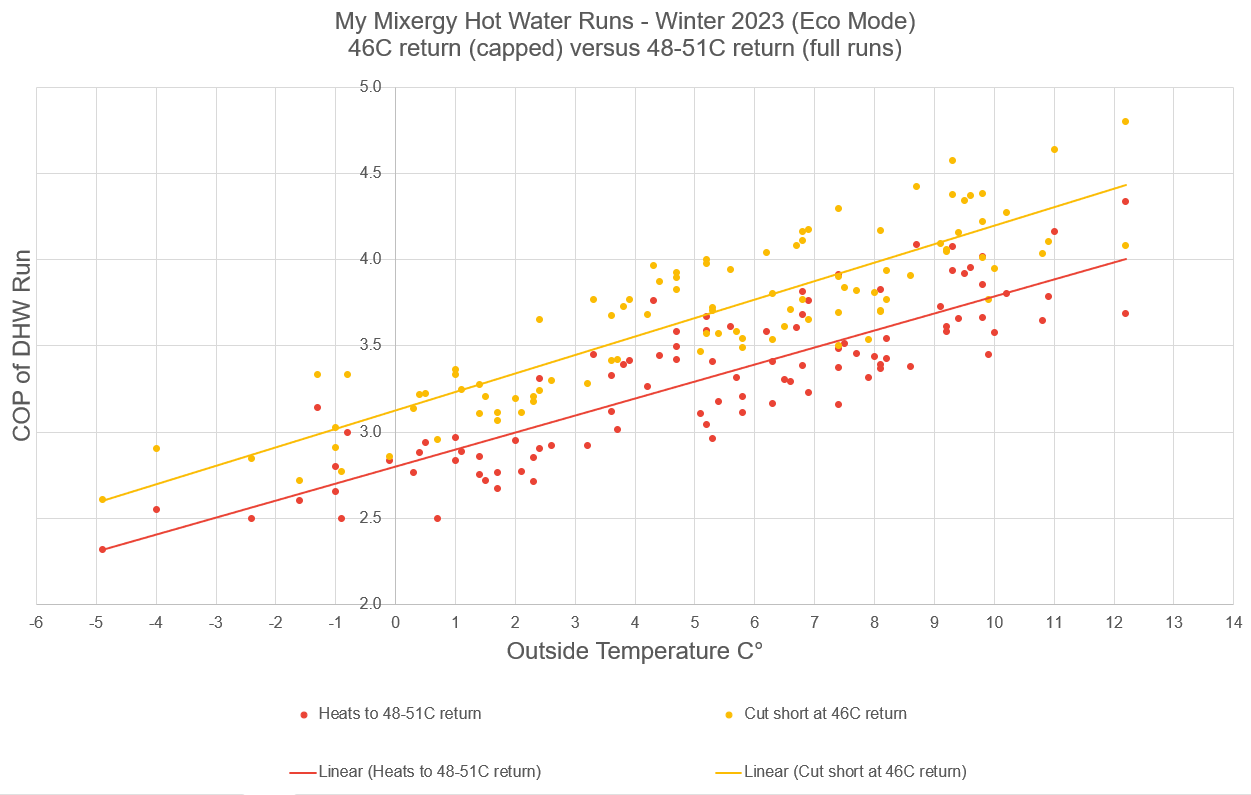
When it’s sub zero you lose about 0.2 to 0.3 COP between the two targets.
But as the outside temperature warms up the trendline looks to expand, with a gap rising to 0.4
I wonder if this opening gap will continue as we head into spring and summer?
This comparison here reiterates that if you are after the very best performance and you want to be #topofthescops, then choosing the lowest target temperature possible will yield the best efficiencies.
How to extend run times past 120 minutes on a Vaillant
When you drop into Eco mode for hot water you reduce how hard the compressor needs to work. This reduces both the electricity in and the heat output to lower levels than Normal mode.
But doing this means your hot water run times are going to be longer.
On the Vaillant you might even hit the default 120 minute limit.
You can Max cyl charge time to off
This should allow runs to extend past 2 hours.
This option, along with Cyl. charge. anti-cycl time are on your indoor controller (installer menu); domestic hot water menu
- Max cyl charge time : off
- Cyl. charge. anti-cycl time: 0 min
The Cyl. charge. anti-cycl time setting controls how long the heat pump waits to start the hot water run again after pausing following Max cyl charge time (say you had it at 120 mins).
You could put Cyl. charge. anti-cycl time at 30 mins to allow the heating to come on for 30 mins before hot water tried to complete.
The obvious downside of having longer hot water run times is that you house will not be heating during this time. Your heat pump can only do one job at a time.
So if you have a house with a high heat loss you may not want to have the heating off for such long periods.
How to get best hot water efficiency with a heat pump
- Empty the cylinder as much as possible. Starting with a colder tank yields better performance. Constant small top ups are not good for performance.
- Use Eco (or a similar low compressor mode).
- Choose a lower target temperature. Heat pump performance gets gradually worse the hotter they have to heat to.
- Schedule hot water runs when it is warmer outside. Higher outside temperature gives better performance. So maybe daytime rather than overnight.
In my setup I have put the DHW flow rate to 100% to close the DT, so that the heat pump doesn’t have to work as hard.
The Mixergy stops the hot water run when it detects that the whole tank temperature hits target (using its internal sensors). Which is essence is when return temperature is greater than the target temperature.
So using a narrow DT means you don’t have to go too far past target temp.
If you had a wide DT, say DT7, you would have let the flow get an extra 5C hotter than you would with DT2.
And on Eco, on a 5kW Vaillant, it could be an extra 30 minutes run time (and energy) to raise my 250L cylinder 5 degrees.
I also run the external Mixergy pump on setting III, so that we get the most turbulence at the bottom of the cylinder to encourage as much heat transfer as possible.
Remember the efficiency savings noted earlier
- Eco versus Normal: 0.4 to 1.0 COP
- 46C target versus 50C target: 0.2 to 0.4 COP
- Cold tank versus ‘top ups’: 0.5 to 1.0 COP
Couple these three changes together and you’ve got some impressive efficiency gains.
But what if you’re a person that is more interested in saving money?
Increasing your hot water efficiency can help do that. But maybe you have the option of off-peak electrical tariffs or perhaps you have solar PV?
So you might be better choosing a higher target temperature and utilising the cheaper rate of electricity or indeed free energy from your roof top. ie, getting more bang for your buck from a combination of cheaper energy and higher target temp (for more usable hot water).
Note: using a PV diverter is only 100% efficient, so you’d be better either storing the PV in batteries and doing a heat pump hot water run or just doing the hot water run when the sun is shining.
Either way, potential 400% heat pump hot water is always better than 100% PV diversion via the immersion element.
My Response to the Heatgeek Mixergy YouTube Video
I’m a big fan of Adam at Heat Geek. I love his stuff and have recently completed his Awakening and Mastery training courses, which are totally stunning and recommended by the way.
But that doesn’t mean I have to agree with everything he says, like his recent video and opinions about the Mixergy cylinder.
Having owned my Mixergy cylinder for 2 years I think I’m well placed to make a comment on the video, so here goes.
Mixergy Smart Stuff
The article makes some very good initial points like Mixergy being great for direct electric, gas, smart tariffs and partial loading.
Most of which I found to my advantage when I first had my cylinder installed, running off direct electricity in my pre heat pump stage that I mentioned at the start of this article.
All good so far, but then we get to the bit I don’t agree on.
“The Mixergy is less efficient with a heat pump”
Heat Geek said: “Heat pumps actually work less efficiently with a Mixergy compared to a cheaper, higher quality, correctly set up standard cylinder”
I think I’ve proved in all the comparison data in this article that this is simply not the case.
The Mixergy performs just as well as Heat Geek’s own custom built dual coil cylinder under the same circumstances.
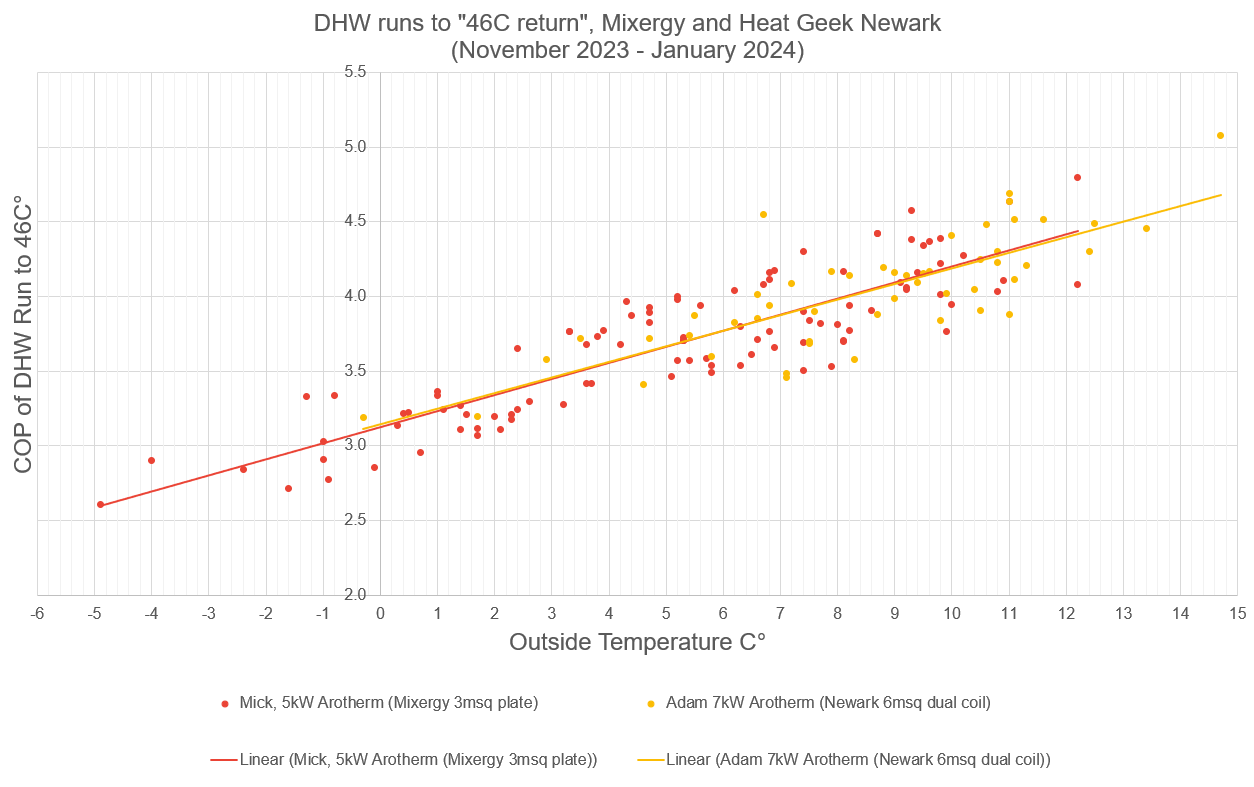
Anti-Legionella
“Unless you set your heat pumps target temperature to extra high to run an anti-legionella program, you’ll have to use the 100% efficient immersion anti-legionella”
This isn’t quite correct. You can choose a low target cylinder temp for 7 days, say 51C. And then in the app you can choose an anti-legionella target temp, say 60C and which day(s) of the week you’d like that to run.
The cleansing cycle counter keeps track in the background how long it has been since the tank reached your anti-legionella temp and will do a cleansing run at least once every 2 weeks.
If your heat pump is capable of going to 60C then it will use the heat pump. If it’s not capable of reaching 60C it will use the heat pump to take the water as high as it can go then use the immersion to take it the rest of the way.
He then says you can do this on a normal cylinder by varying the target temperature. Which is exactly what the Mixergy does for you? ie. Normal target mode versus legionella/cleansing temperature. But the Mixergy does this in a smarter way because of the 2 week checker and the app?
Personally, I follow Heat Geek’s own advice and I don’t worry too much about legionella.
I currently have my cylinder target set to 48C and my cleansing temp set to 51C.


Other Mixergy advantages not mentioned
On the Mixergy we can heat ALL of the tank to target temperature we get more usable water.
Ie, we don’t end up with a bit of cold at the bottom of the cylinder below the coil.
On a conventional cylinder, as the water is used, the top of the cylinder mixes with cold to reduce the temperature of the stored water.
So you may have targeted 50C water, but as you use hot water, the top of the cylinder will eventually drop in temperature.
But on a Mixergy, because of the defined thermocline, when the 250L Mixergy says it only has 20% left, it will have 50L of usable water, all at the target 50C temp.
So in essence, you get more usable water from the whole tank with a Mixergy.
I’ve been down at 5% on my cylinder and I still got the same target temperature hot water out.
Also, because the plate is piped right to the bottom of the cylinder, we always start by heating the very coldest water, so keep the flow temps low for best efficiency.
Again, this is explained in the Mixergy video
Mixergy also produced a very detailed article comparing plate heat exchangers to coils.
Plate heat exchanger vs Coil: the great debate!
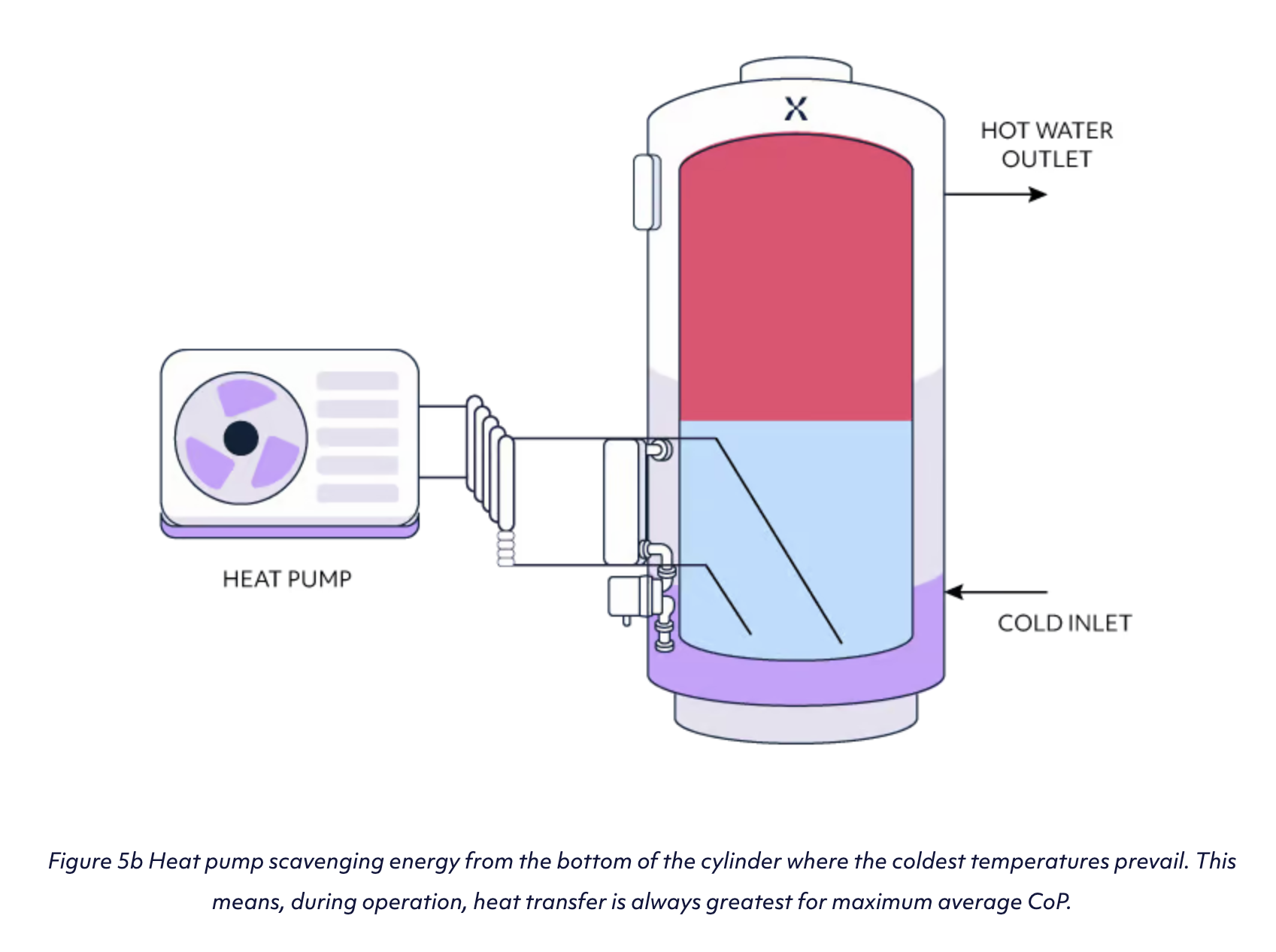
Another advantage of Mixergy is that it is internet connected which means that new features can easily added. I think there is going to be lots of possibilities around demand flexibility services foe example. ie, getting paid to fire up a hot water run when there’s an abundance of energy on the grid (and get paid for doing it).
So the Mixergy is well placed to move with future grid requirements and demands.
At the end of the video Heat Geek says the Mixergy is a good fit if you’re on gas, direct electric, have solar PV or going on a journey that eventually leads to a heat pump.
All of which I agree totally with, because that has almost been my journey.
Value for Money
Adam raises a valid argument on price and the value for money of a Mixergy compared to conventional cylinders.
But be careful, as not every ‘normal cylinder’ is the same.
There is a sliding scale of price too (correct as of January 2024)
- Mixergy 250L (£1,540) + heat pump kit (£414) (3msq equiv plate) = £1,954
- Newark Heat Geek 250L (6msq coil) = £1,869 (retail price*)
- Vaillant Unistor 250L (2.4msq) = £1275
- Newark Standard 250L (3.24msq coil) = £1,245
- Telford Tempest 250L (3msq coil) = £952
- McDonald Steelflow 250L (3msq coil) = £947
(*) – This is retail / end user price, although there are discounts for Heat Geek engineers. The same 250L cylinder can be as low as £1442 when installed by a Heat Geek trained installer.
What you are after is a cylinder with a big heat pump ready coil. The bigger the coil the better performance you should get out of it. Which is why the Heat Geek Newark has a 6msq coil.
But as we’ve seen in my tests, hot water efficiency on a heat pump is not only about coil or plate size, it’s about how the heat pump delivers that heat to the cylinder.
The general advice though is always to get the biggest sized coil or plate heat exchanger that you can.
The Mixergy is more expensive that other cylinders, but you’ve got to remember the journey that the Mixergy cylinder can go on with you. Buy once and it will be capable of a whole host of jobs. It also have all the cloud services / app etc on it’s side, now and in the future with software updates.
But if you’re only in the market for a heat pump only cylinder, then you may want to consider the Heat Geek designed Newark (fitted by a Heat Geek trained installer).
A Complaint – Mixergy can only go as low as 50C target temperature
So this is a gripe of mine with Mixergy. When using their app you can only currently choose a target temperature between 50C and 60C, in 1C increments.
UPDATE FROM THE FUTURE: This has now been resolved. You can choose 45C or lower for your target temperature in the app.
When I first got my cylinder you were able to choose a high of 65C, which was great for sending surplus PV to. Ie, filling the cylinder with as much usable water as possible.
But I think they reduced the maximum temperature down after some users complained the water was getting too hot!?!?
I don’t see why this nanny state is needed? On the Vaillant controls you can choose up to 70C hot water. Maybe you shouldn’t, but surely it’s up to the user to decide?
Personally, I have a thermostatic mixing valve in front of the cylinder so I can set what temperature I want all the water that comes into the house.

So the tank might be full of 60C water, but it only comes out at 45C to all taps because of the mixing valve.
During the period of time creating this article I have been experimenting running my Mixergy hot water runs to between 48C and 51C.
But I hear you cry “48C is below the official 50C lower limit available via the app isn’t it?”
Yes it is, but I have been able to do this via Tom McGuiness fantastic Mixergy integration for Home Assistant.
https://github.com/tomasmcguinness/homeassistant-mixergy
Using the integration, I can poke temperatures outside of the app range. Like below 50C.
Obviously, as with any integration that pokes commands via an API, proceed with caution.
It would be useful, especially if you’re chasing performance, to be able to choose 45C target temperature for hot water runs within the official app.
Personally, 48C works for me. It’s just enough to cope with 4 x showers in an evening and washing the pots etc. 45C just wouldn’t quite give me enough usable water.
I’m planning on a separate article all about target temperatures and mixing calculations.
Summary and closing thoughts
When I started writing this article I wanted to counter the argument that the Mixergy cylinder had poor performance with a heat pump.
Last winter I was quite vocal about its performance but it turned out it was all my fault.

I was wrong to question the capabilities of the Mixergy.
If you were dead set on a Mixergy, but heard some of performance woes online, fear not. The Mixergy more than capable of holding its own with the best coil based cylinder out there.
As the stats show, the Mixergy can produce amazing performance results with a heat pump. 480% efficient when 12C outside?!?!
But just like every cylinder (plate or coil based), you have to deliver the heat efficiently to get the best performance.
You can read as many articles as you want, but you can’t argue with real world data.
I hope this article helps clarify things.
Referral information and free credit offer
If you find the content of this website useful and are thinking of joining Octopus Energy, please consider using my referral code or ‘buy me a coffee’ to help support running costs of the website (hosting fees / cloud servers etc).
If you’re thinking of switching energy suppliers, homeowners that use this referral code can claim £50 of free Octopus Energy credit after sign-up: https://mickwall.octopus.energy
Business users that switch and sign-up using the same code with be granted £100 of free credit.
Get a £100 gift card when signing up for Solar or a Heat Pump installation through Octopus Energy using this link: https://tech.referrals.octopus.energy/ucMTeP8d
If you would like to ‘buy me a coffee’ to show support, please use this link: http://buymeacoffee.com/SVHgIbUYM
Energy Stats UK can be found on various social media platforms posting daily tariff pricing graphs and summaries.
Be sure to follow @energystatsuk on Twitter / X, Bluesky, Mastodon and Instagram.
Note: The current and past performance of energy pricing is not necessarily a guide to the future.



